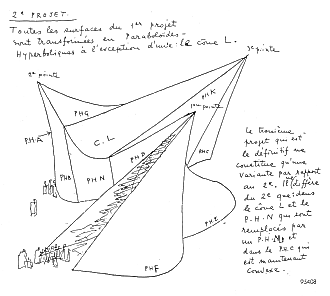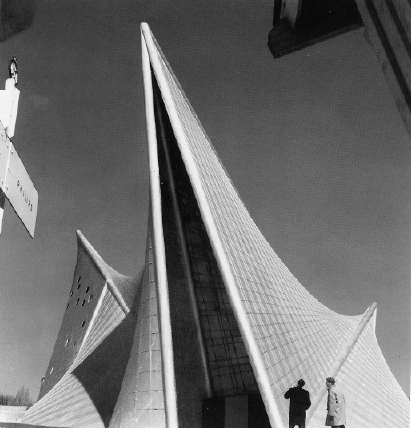
from: http://home.wanadoo.nl/eli.ichie/biographyxenakis.html#music "After writing some early works in the late 1940s, Xenakis' first mature work is Metastasis. At its premiere in 1955 it caused a scandal because it did not deal with serialism, incorporating sound blocks and masses of glissandi instead. This composition is the first where Xenakis, still intuitively, uses mathematical calculations as the basic musical material.
"After writing some early works in the late 1940s, Xenakis' first mature work is Metastasis. At its premiere in 1955 it caused a scandal because it did not deal with serialism, incorporating sound blocks and masses of glissandi instead. This composition is the first where Xenakis, still intuitively, uses mathematical calculations as the basic musical material.
In later works Xenakis started to introduce the probability theory, leading to his so calle Stochastic music.
But he continues searching for new roads and possibilities, resulting in compositions like Duel and Stratégies, based on game-like strategies or Evryali, a composition using aborescences, tree-like branching curves.
From early on and throughout his compositional career, Xenakis composed tape music. His first work is Diamorphoses from 1957 and his most recent composition is S.709 of 1994. In his later tape works he uses computers as well. A fine example of his tape music is Concret PH, composed in 1958 as an overture to Varèse's Poème électronique in the Philips Pavilion at the Expo in Brussels. Part of many of his large scale instrumental and electronic works is the use of light effects, slide shows and laser projections. Examples of these works are his Polytopes, Diatope and Mycènes alpha.
Even though the use of all mathematical theories, which is a method for Xenakis to avoid putting emotion in his music, it definitely is music with beauty, power and character. The brutal sound-blocks of Cendrées and Nomos Gamma, the sweeping rhythms of Psappha and Kottos and the screaming glissandi of Metastasis and Mikka S nevertheless bear emotions that grow on further listening. It definitely isn't easy music, but being a world in itself, it is extremely rewarding.
1958 - Philips Pavilion Poème Electronique, by Le Corbusier, Iannis Xenakis, and Edgar Varèse Philips Industries commissioned Le Corbusier to build their pavilion for the 1958 World's F
Philips Industries commissioned Le Corbusier to build their pavilion for the 1958 World's F air to be a showcase of their technology. Iannis Xenakis was working for Le Corbusier at the time and ended up designing the building as well as writing music for some of the spaces (Concret P.H.. Le Corbusier designed the visuals for the inside and chose Edgar Varèse to create the music for the main space. It was an extremely complex installation with 350 speakers, all sorts of lights, slide and film projectors, sculpture and more. Xenakis' music and architecture was heavily based on mathematics, especially hyperbolic paraboloid shapes. Edgar Varèse worked in Philips then new sound studio in Eindhoven with two full-time technitions to create the main musical piece. Le Corbusier worked with his firm to create the visuals.
air to be a showcase of their technology. Iannis Xenakis was working for Le Corbusier at the time and ended up designing the building as well as writing music for some of the spaces (Concret P.H.. Le Corbusier designed the visuals for the inside and chose Edgar Varèse to create the music for the main space. It was an extremely complex installation with 350 speakers, all sorts of lights, slide and film projectors, sculpture and more. Xenakis' music and architecture was heavily based on mathematics, especially hyperbolic paraboloid shapes. Edgar Varèse worked in Philips then new sound studio in Eindhoven with two full-time technitions to create the main musical piece. Le Corbusier worked with his firm to create the visuals.
<< preface
this blog is nina wenhart's collection of resources on the various histories of new media art. it consists mainly of non or very little edited material i found flaneuring on the net, sometimes with my own annotations and comments, sometimes it's also textparts i retyped from books that are out of print.
it is also meant to be an additional resource of information and recommended reading for my students of the prehystories of new media class that i teach at the school of the art institute of chicago in fall 2008.
the focus is on the time period from the beginning of the 20th century up to today.
it is also meant to be an additional resource of information and recommended reading for my students of the prehystories of new media class that i teach at the school of the art institute of chicago in fall 2008.
the focus is on the time period from the beginning of the 20th century up to today.
>> search this blog
2008-06-26
>> Iannis Xenakis
Gepostet von
Nina Wenhart ...
hh:mm
1:32 PM
tags -
early new media,
experimental music
![]()
Bookmark this post:blogger tutorials
Social Bookmarking Blogger Widget |
Subscribe to:
Post Comments (Atom)
>> additional class blogs
>> labels
- Alan Turing (2)
- animation (1)
- AR (1)
- archive (14)
- Ars Electronica (4)
- art (3)
- art + technology (6)
- art + science (1)
- artificial intelligence (2)
- artificial life (3)
- artistic molecules (1)
- artistic software (21)
- artists (68)
- ASCII-Art (1)
- atom (2)
- atomium (1)
- audiofiles (4)
- augmented reality (1)
- Baby (1)
- basics (1)
- body (1)
- catalogue (3)
- CAVE (1)
- code art (23)
- cold war (2)
- collaboration (7)
- collection (1)
- computer (12)
- computer animation (15)
- computer graphics (22)
- computer history (21)
- computer programming language (11)
- computer sculpture (2)
- concept art (3)
- conceptual art (2)
- concrete poetry (1)
- conference (3)
- conferences (2)
- copy-it-right (1)
- Critical Theory (5)
- culture industry (1)
- culture jamming (1)
- curating (2)
- cut up (3)
- cybernetic art (9)
- cybernetics (10)
- cyberpunk (1)
- cyberspace (1)
- Cyborg (4)
- data mining (1)
- data visualization (1)
- definitions (7)
- dictionary (2)
- dream machine (1)
- E.A.T. (2)
- early exhibitions (22)
- early new media (42)
- engineers (3)
- exhibitions (14)
- expanded cinema (1)
- experimental music (2)
- female artists and digital media (1)
- festivals (3)
- film (3)
- fluxus (1)
- for alyor (1)
- full text (1)
- game (1)
- generative art (4)
- genetic art (3)
- glitch (1)
- glossary (1)
- GPS (1)
- graffiti (2)
- GUI (1)
- hackers and painters (1)
- hacking (7)
- hacktivism (5)
- HCI (2)
- history (23)
- hypermedia (1)
- hypertext (2)
- information theory (3)
- instructions (2)
- interactive art (9)
- internet (10)
- interview (3)
- kinetic sculpture (2)
- Labs (8)
- lecture (1)
- list (1)
- live visuals (1)
- magic (1)
- Manchester Mark 1 (1)
- manifesto (6)
- mapping (1)
- media (2)
- media archeology (1)
- media art (38)
- media theory (1)
- minimalism (3)
- mother of all demos (1)
- mouse (1)
- movie (1)
- musical scores (1)
- netart (10)
- open source (6)
- open source - against (1)
- open space (2)
- particle systems (2)
- Paul Graham (1)
- performance (4)
- phonesthesia (1)
- playlist (1)
- poetry (2)
- politics (1)
- processing (4)
- programming (9)
- projects (1)
- psychogeography (2)
- publications (36)
- quotes (2)
- radio art (1)
- re:place (1)
- real time (1)
- review (2)
- ridiculous (1)
- rotten + forgotten (8)
- sandin image processor (1)
- scientific visualization (2)
- screen-based (4)
- siggraph (1)
- situationists (4)
- slide projector (1)
- slit scan (1)
- software (5)
- software studies (2)
- Stewart Brand (1)
- surveillance (3)
- systems (1)
- tactical media (11)
- tagging (2)
- technique (1)
- technology (2)
- telecommunication (4)
- telematic art (4)
- text (58)
- theory (23)
- timeline (4)
- Turing Test (1)
- ubiquitious computing (1)
- unabomber (1)
- video (14)
- video art (5)
- video synthesizer (1)
- virtual reality (7)
- visual music (6)
- VR (1)
- Walter Benjamin (1)
- wearable computing (2)
- what is? (1)
- William's Tube (1)
- world fair (5)
- world machine (1)
- Xerox PARC (2)
>> timetravel
-
▼
08
(252)
-
▼
6
(56)
-
▼
26
(21)
- >> Edward Ihnatovicz, "Portrait of the Artist as a...
- >> Franz Gsellmann's world machine (1958 - 1981)
- >> Theo Jansen, "Strandbeest"
- >> Ken Rinaldo, Autopoiesis, 2001
- >> Edward Ihnatovicz, SAM - Sound Activated Mobile
- >> Grey Walter
- >> Iannis Xenakis
- >> Edward Ihnatovicz, "Senster", 1970
- >> Gordon Pask
- >> Jack Burnham
- >> Cybernetic Serendipity, ICA London, August 2nd ...
- >> Vladimir Bonacic
- >> [Nove] Tendencije, BIT international
- >> Charles Csuri, "Random War", "Humming Bird", mi...
- >> Vera Molnar
- >> Manfred Mohr
- >> Georg Nees
- >> Wiener, Rosenblueth, Bigelow "Behaviour, Purpos...
- >> Anestis Logothetis
- >> Frieder Nake, Hommage à Paul Klee, 1965
- >> A. Michael Noll, Computer Composition with Line...
-
▼
26
(21)
-
▼
6
(56)
>> cloudy with a chance of tags
followers
.........

- Nina Wenhart ...
- ... is a Media Art historian and researcher. She holds a PhD from the University of Art and Design Linz where she works as an associate professor. Her PhD-thesis is on "Speculative Archiving and Digital Art", focusing on facial recognition and algorithmic bias. Her Master Thesis "The Grammar of New Media" was on Descriptive Metadata for Media Arts. For many years, she has been working in the field of archiving/documenting Media Art, recently at the Ludwig Boltzmann Institute for Media.Art.Research and before as the head of the Ars Electronica Futurelab's videostudio, where she created their archives and primarily worked with the archival material. She was teaching the Prehystories of New Media Class at the School of the Art Institute of Chicago (SAIC) and in the Media Art Histories program at the Danube University Krems.



No comments:
Post a Comment